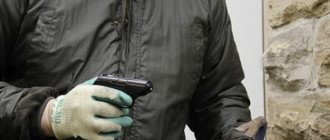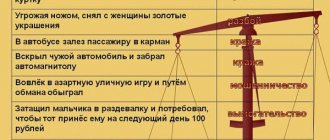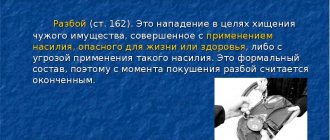Theft is considered the most common crime in Russia. The object of this act is always someone else’s property - a thing belonging to a specific citizen, collective, legal entity or state.
According to Part 2 of Art. 8 of the Constitution of the Russian Federation recognizes and protects all forms of property equally. To qualify this illegal act, it is not necessary to establish the specific form of property that the criminal is encroaching on. It is established when assessing the social danger of the offense committed and is reflected in the case materials along with other grounds. Let's take a closer look in our article at what theft is from a legal point of view.
What is the object of theft?
A mandatory element of theft is a specific object. It is directly private, state, municipal, or other property in relation to which a criminal attack has been committed. Such a crime does not exclude the possibility of encroachment on an additional object, for example, when illegal entry into a home for the purpose of theft is an attack on public relations related to the privacy of citizens, their personal and family secrets.
Item of theft
This includes various property, a list of which is given in Art. 128 Civil Code of the Russian Federation. The Criminal Code of the Russian Federation does not indicate what types of property may be the subject of theft. But it must have the following characteristics:
- material;
- economic;
- legal.
It follows from the powers of the owner that he is a thing that is calculated in number, volume, weight, quantity. The right of ownership is based on the right of possession - physical possession of a thing, as a result of which a citizen can use and dispose of it at his own discretion. Possession is exercised only in relation to a material thing limited in space. For example, the subject of theft cannot be computer information, intellectual property, or electricity. If illegal actions were committed against them, then such actions are qualified as causing property damage to the owner by deception or abuse of trust (Article 165 of the Criminal Code of the Russian Federation), unlawful access to computer information (Article 272 of the Criminal Code of the Russian Federation), violation of copyright and related rights (Article 146 of the Criminal Code of the Russian Federation).
Note!
An object can only be movable things that can move in space without losing their intended purpose and consumer properties. Another property is their estimated value.
It is necessary to distinguish theft from environmental crimes. The correct definition of the social good that the crime is aimed at is of great importance for distinguishing attacks. The subject of theft cannot be natural resources into which human labor is not invested - wild animals, forest, etc. Illegal fishing is qualified under Art. 256 of the Criminal Code of the Russian Federation. Only its removal from an artificial reservoir is regarded as theft.
They are not given documents that give the right to receive property - powers of attorney, invoices, policies, promissory notes, wills. But documents equivalent to money or material assets - postage stamps, coupons for fuel and lubricants, lottery tickets - can be used as an object. This also includes securities - bills, checks, bonds, savings and certificates of deposit, etc. If other securities are stolen, there is no element of theft, such an act is qualified as preparation for fraud.
You can only steal someone else's property. This is a sign that characterizes the legal side of the qualification of an act. It is always owned or legally owned by another person.
The theft of certain types of property, which is withdrawn from civil circulation, forms independent elements of crime. These include psychotropic, narcotic, explosives, ammunition, weapons, radioactive materials, explosive devices.
Prevention and prevention
It is worth concentrating specifically on those preventative and warning measures that every citizen can take to protect themselves from theft. In this case, according to experts, the crime can be prevented.
To prevent pickpocketing, the Ministry of Internal Affairs recommends:
- In crowded places, be vigilant about your bags and wallets, including their integrity, try to put your wallet or phone in your pocket so that they do not stick out from your clothes, thereby not attracting the attention of pickpockets.
- Do not count cash in front of other people, and also watch out for people who stand too close to you.
To prevent theft from homes:
- Install reliable protection for your home: bars on the windows, strong locks on the doors (high security locks), install an alarm system. Moreover, even an imitation of an alarm can scare away thieves and thereby protect you from theft.
- Do not tell strangers your work and vacation schedule, empty your mailbox on time (the presence of a large amount of paper correspondence in the mailbox is a clear signal of your long absence).
- Do not trust strangers with the keys to your apartment, do not tell where spare keys are kept. Also, do not store duplicates in easily accessible and obvious places: in mailboxes, under the rug at the front door.
- Regularly carefully inspect the entrance doors, windows and balconies for the presence of so-called “thieves' checks”: stretched threads, lying cookies. If these items are not damaged for a long time, persons intending to commit theft will understand that no one is watching the apartment, no one is inside, which means they can safely commit a crime.
- When entering the entrance, you should not let strangers inside. It is worth telling them to call the intercom of the apartment they are going to.
To prevent vehicle theft:
- Install the maximum possible number of anti-theft devices: locking the steering wheel, hood, wheels, gearbox.
- If possible, apply some bright distinctive signs to the car: large stickers, color airbrushing.
- Try not to leave bags, wallets, or other valuables in the car. They are the ones who can attract the attention of potential criminals.
Objective and subjective side of theft
The objective side is a set of characteristics established by law that characterize an external act of socially dangerous encroachment on a protected object. It is a form of action through which the criminal steals property secretly. Signs of theft are:
- the active actions of the perpetrator must be illegal and pose a public danger;
- gratuitousness - the seizure is made without remuneration or with a symbolic payment in the form of a certain amount;
- the theft is carried out secretly;
- only other people's property is confiscated;
- the occurrence of adverse consequences for the owner after the crime committed.
Each individual attribute is mandatory. The theft is considered completed at the moment the criminal receives the opportunity to dispose of the stolen property at his own discretion.
The subject must have three characteristics:
- sanity;
- reach 14 years of age;
- be an individual.
When determining the circumstances of a theft committed by a child under 14 years of age, it may turn out that the crime was committed at the instigation of an adult. In this case, the instigator must be considered the subject of the crime.
If a sane person incites an insane person to commit theft, then the person who instigated the crime is the subject of the theft, as explained by the Plenum of the Armed Forces of the Russian Federation in Resolution No. 29 of December 27, 2002.
The absence of a selfish purpose when taking possession of someone else's property does not constitute theft or robbery. For example, the attacker acted with the aim of temporarily using the property and then returning it to the owner, or he assumed that he had a right to it. The Criminal Code of the Russian Federation provides a separate article for the theft of vehicles without the purpose of theft.
Note!
The direction of intent during theft is distinguished by the goals and presence of selfish motives - the desire of the attacker to meet his own material needs at the expense of someone else's property.
Independent signs of the subjective side of theft are purpose, motive and guilt. The latter presupposes the presence of direct intent in the act, aimed at the gratuitous and illegal seizure of things for use in one’s own favor, or for transfer to other persons for mercenary purposes. A volitional action is performed on the basis of a motive for certain goals set by the criminal. They are served by the conscious motivation of the guilty person, his internal driving force. The criminal makes the decision to commit theft, guided by his own needs and interests. The motive may be revenge, resentment, hooliganism.
Theft (Article 158 of the Criminal Code of the Russian Federation). Criteria for secrecy. Distinguishing theft from related crimes.
Theft is the secret theft of someone else's property.
A generic object is a set of social relations in the economic sphere.
A species object is a set of social relations that ensure ownership or other legal rights to own, use, and dispose of property.
The direct object is the right of ownership or other rights.
Subject – movable and immovable property (which is not connected to the earth (space ships, plantings)
The objective side of theft is the secret seizure of someone else's property. Theft in relation to theft is understood as the secret non-violent seizure of someone else's property. The question of whether the theft is secret must be decided on the basis of a subjective criterion, i.e. based on the perception of the situation of theft by the perpetrator himself.
Theft should be classified as theft in the following cases:
1) Seizure of property in the absence of the victim or third parties.
2) Confiscation of property in the presence of the victim, but unnoticed by him (the victim is intoxicated, unconscious, asleep, or the victim is not aware of the nature of the actions that are being committed against him, for example, pickpocketing).
3) Seizure of property in the presence of third parties who actually observe the seizure, but do not realize the social danger of this act.
4) Seizure of property in the presence of a close relative who is aware of the wrongfulness of the act, but does not expect wrongfulness on the part of the perpetrator. The theft is considered completed from the moment the property is confiscated and the perpetrator has a real opportunity to dispose of the stolen property at his own discretion.
By design, the elements of theft are material, because its objective side, as a mandatory feature, includes a socially dangerous consequence in the form of property damage. The subject of the crime is a sane individual who has reached 14 years of age. The subjective side of theft is characterized by guilt in the form of direct intent and selfish motive and pursues the goal of illegally obtaining property benefits.
Qualified types of theft (Part 2 of Article 158 of the Criminal Code) are characterized by its commission:
a) by a group of persons by prior conspiracy; (the number of co-perpetrators is 2 or more persons; a preliminary agreement between the accomplices before the attempted theft. Theft committed by a group of persons without prior conspiracy is qualified under Part 1 of Article 158 of the Criminal Code, however, the court has the right to recognize a group method of committing a crime as an aggravating circumstance (para. 3 clause 12 of the Supreme Court's PP “On judicial practice in cases of theft.
Features in the method of withdrawal. Secret seizure has 2 criteria:
1. Objective - means that the person actually acts unnoticed by other persons;
There may be options here:
1) the seizure occurs in the absence of the owner, legal owner, or unauthorized persons;
2) the seizure occurs in the presence of the above-mentioned persons, but unnoticed by them.
3) seizure is possible in the presence of the above-mentioned persons, noticeable, obvious to them, but they do not create a criminal illegal nature of the actions of the perpetrator (for example, stealing things at a station);
4) property is confiscated in the presence of other persons, it is obvious to them, but they do not want to interfere with the confiscation because they approve of it.
2. Subjective – means the mental attitude of the criminal during the seizure process, i.e. he wants to act secretly and unnoticed by the owner or third parties;
When there is a conflict between objective and subjective criteria, preference is given to the subjective criterion. If the person himself believed that he was acting secretly, but in fact the process of confiscation of property was observed by someone, then the action of the perpetrator is classified as theft.
The secrecy of the seizure arises due to the current situation, but in some cases it is created or ensured by criminals deliberately. Since the method is a mandatory sign of the objective party, the persons ensuring the secrecy of the seizure are recognized as co-perpetrators of the crime committed.
Theft is a non-violent crime. This means that property is confiscated against the will of the victim. In cases where the actions of the culprit began as theft, but were then discovered by the owner or third parties, but the process of seizure continued, there is a escalation of the theft into robbery or robbery, respectively.
If violence was used after the theft was committed in order to avoid arrest, then there is no escalation. The actions of the perpetrator are classified as theft and a crime against the person.
The elements of theft are material; the crime is over when the property is confiscated and the offender has the opportunity to dispose of it.
The subjective side is characterized by direct intent. The goal is selfish (the desire to extract benefits, advantages for oneself or third parties).
Subject is a sane individual who has reached the age of 14.
1. Distinguishing theft from fraud:
- in case of theft, the subject of theft can only be property; in case of fraud - both property and the right to property;
- in case of theft, property is confiscated from the victim against his will, i.e. secretly; in case of fraud, the owner himself transfers the property to the criminal, having been misled by him, as a result of deception or abuse of trust;
- in case of fraud, the property must be transferred to the criminal by a legally capable person whose actions to dispose of the property are legally significant;
If, by deception or misappropriation of trust, the property of an incapacitated or partially capable person is taken over, then there is theft, not fraud.
- in case of fraud, a person transfers property to a criminal to exercise any legal powers: possession, use, disposal.
If the owner himself transfers the property to the criminal, not to fulfill powers, but to perform any technical functions, and this property is confiscated, then there is theft, not fraud. Elements of deception can be present not only in fraud, but also in theft: but if in fraud, deception is a way of taking property, then in theft, deception is aimed at gaining access to property, which is subsequently seized secretly.
2. Distinguishing theft from misappropriation and embezzlement (Article 160 of the Criminal Code)
The difference occurs according to the characteristics of the subject. The subject of misappropriation and embezzlement is the person to whom the property is entrusted legally (employment contract, civil law contract, etc.), and the perpetrator uses these powers. In case of theft, the subject is a person who has nothing to do with the stolen property; in some cases, he simply has access to property due to his official position.
3. Distinguishing theft from robbery (Article 161 of the Criminal Code);
We take the method of extraction as the basis for delimitation. In case of theft - secret, in case of robbery - open seizure. Subjective factors are also taken into account.
4. Delineation of theft from Art. 166 of the Criminal Code (wrongful seizure of a car or other vehicle without the purpose of theft;
— the main difference is that theft is theft; Art. 166 of the Criminal Code - other crime against property;
- in case of theft, property is confiscated for mercenary purposes; in case of hijacking, the goal is either not selfish at all; if it is selfish, then it is satisfied in a different way than with theft.
Qualified types of theft:
1. item “a” part 2 art. 158 of the Criminal Code – theft committed by a group of persons by prior conspiracy;
The group must have common characteristics of participation, i.e. 2 or more persons who are subjects of a crime. Moreover, in form it should only be co-perpetrator, when at least 2 persons perform the objective side of the crime. The complexity of complicity does not form this qualifying feature.
In case of theft, both types of co-execution are possible: with parallel co-execution, all group members perform the objective side in full or in part in parallel in time and space; with sequential co-execution, the objective side of the theft is divided into several stages and each of the accomplices performs his own stage. An agreement is recognized as preliminary when it is achieved before the objective party begins to execute.
P. “a” part 2 art. 158 of the Criminal Code occurs when the conspiracy of a group of persons is of an elementary nature, i.e. a group is formed to commit one crime, after which it disbands.
2. item “b” part 2 art. 158 of the Criminal Code - theft committed with illegal entry into a premises or other storage facility;
Penetration can be accomplished in two ways:
1) intrusion into premises secretly or openly, with or without overcoming obstacles, using deception;
2) using various devices: when the culprit removes stolen objects without entering the premises or storage (magnets, fishing rods, hooks, trained animals, etc.)
“ premises ” is understood as a structure or structure, regardless of the form of ownership, intended for the temporary residence of people or the placement of material assets for production or other official purposes. These can be: administrative, industrial premises, retail stores, educational premises.
“ Storage ” refers to utility premises separated from residential buildings, areas of territory, and other structures intended for permanent or temporary storage of valuables. These include: devices, places that are designed, specially adapted, equipped, for permanent or temporary storage of material assets and for these purposes are equipped with any devices that prevent penetration into them (seals, fences, bars, etc., which impede access to inventory items).
Storage facilities include certain places, including those in the open air (areas of territory), if they meet the following criteria:
— specially designated for permanent or temporary storage of material assets (parking areas; cattle pens, etc.);
- equipped with a fence or technical means or provided with other security in order to preserve this property.
The sign of allocating an area for storing valuables allows you to delimit the storage from other areas of the territory, which, although protected, functionally have a different purpose.
Thefts committed from open platforms do not contain a sign of penetration (if the platforms were not guarded).
3. p. “c” part 2 art. 158 of the Criminal Code - theft committed with causing significant damage to a citizen;
Only an individual acts as a victim. A significant amount is an amount of at least 2.5 thousand rubles.
3. paragraph “d” part 2 art. 158 of the Criminal Code - theft committed from clothes, bags or other hand luggage that were with the victim;
Clothing is a set of artificial accessories for a person that clothe his body; it includes: underwear, a dress covering it and outerwear worn over the dress, as well as hats, gloves, shoes, etc.
A bag is a product made of fabric, leather and other materials in the form of a small bag, usually with handles, used for carrying something. They can be ladies', household, sports, school, sanitary, hunting, etc.
Carry-on luggage is a briefcase, backpacks, suitcases, cases, suitcases, backpacks, packages, boxes and other means intended for manual carrying, transportation and storage of objects and various non-bulky things.
Consequently, the subject in this case can only be movable property that can be moved with the help of human muscle power.
At the time of seizure, the property must be inside a bag or other carry-on luggage, or in clothing. The theft of items located on top of clothing cannot be classified according to this criterion.
An important sign when qualifying is the presence of clothing and hand luggage with the victim, i.e. in its physical possession or in the field of view of the victim (on the body, on the arm, on the chair, i.e. in the sphere of actual control over this property).
4. paragraph “a” part 3 art. 158 of the Criminal Code - theft committed with illegal entry into a home;
Art. 139.approx. UK: housing - an individual residential building with residential and non-residential premises included in it, residential premises, regardless of the form of ownership, included in the housing stock and suitable for permanent or temporary residence, as well as other premises or buildings not included in the housing stock, but intended for temporary residence.
5. item “b” part 3 art. 158 of the Criminal Code - theft committed from an oil pipeline, oil product pipeline, gas pipeline;
A pipeline is a complex of structures consisting of a linear part, pumping, compressor, distribution, measuring, and reservoir stations and is intended for transporting liquid and gaseous substances.
6. paragraph “c”, part 3, art. 158 of the Criminal Code – theft committed on a large scale,
Large size is the value of property exceeding 250 thousand rubles.
7. paragraph “a” part 4 art. 158 of the Criminal Code – theft committed by an organized group;
Art. 35 of the Criminal Code.
8. paragraph “b” part 4 art. 158 of the Criminal Code - theft committed on an especially large scale -
An especially large amount is defined as the value of property exceeding one million rubles.
Consequences
An objective sign of theft is the harm caused to the owner or other owner of the property at the time the crime is completed. Experts consider damage to be only material and equivalent in value to the stolen item. It does not include losses specified in Part 2 of Art. 15 Civil Code of the Russian Federation.
The consequence of the crime provided for in Part 1 of Art. 158 of the Criminal Code of the Russian Federation, is damage in an amount exceeding 1000 rubles. It should not be significant for a citizen, since then the offender will be punished with imprisonment for up to 5 years. If the amount of damage exceeds 250 thousand rubles (large amount), then the punishment includes up to 6 years of imprisonment and a fine of up to 80 thousand rubles. When theft occurred in the amount of more than one million rubles (a particularly large amount), the sanctions are even more severe - up to 10 years in prison and a large fine.
If you need help or legal advice on this issue, contact our lawyers by phone or online.








